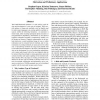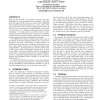100 search results - page 20 / 20 » Foundations of Attack-Defense Trees |
BMCBI
2006
13 years 5 months ago
2006
Background: Multiple sequence alignment is the foundation of many important applications in bioinformatics that aim at detecting functionally important regions, predicting protein...
AMAI
2000
Springer
13 years 4 months ago
2000
Springer
An event space is a set of instantaneous events that vary both in time and specificity. The concept of an event space provides a foundation for a logical--i.e., modular and open-a...
COLING
2002
13 years 4 months ago
2002
The LinGO Redwoods initiative is a seed activity in the design and development of a new type of treebank. While several medium- to large-scale treebanks exist for English (and for...
PVLDB
2008
13 years 4 months ago
2008
With the rise of XML, the database community has been challenged by semi-structured data processing. Since the data type behind XML is the tree, state-of-the-art RDBMSs have learn...
PRIB
2010
Springer
13 years 3 months ago
2010
Springer
Abstract. Supervised classifiers require manually labeled training samples to classify unlabeled objects. Active Learning (AL) can be used to selectively label only “ambiguous�...


